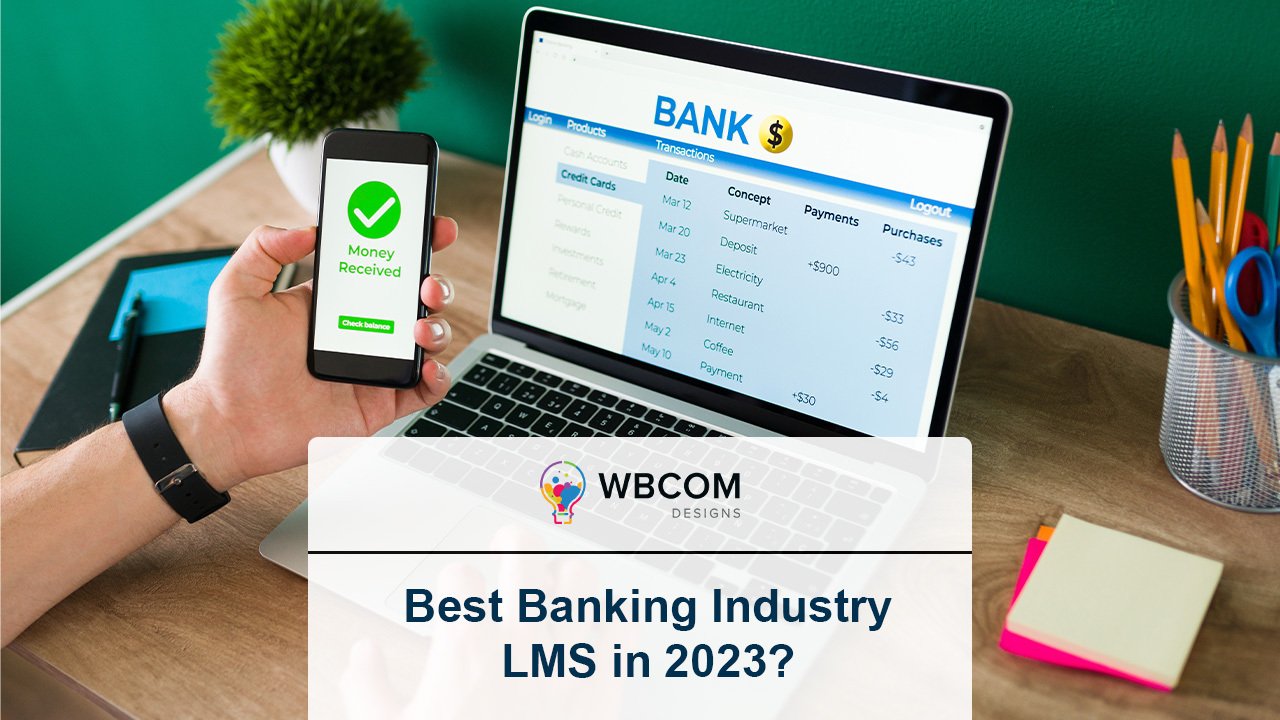Are you tired of outdated and ineffective training methods in the banking industry? Are you struggling to keep up with the ever-changing regulations and technologies? Look no further, as we present to you the Best Banking Industry LMS in 2023! In today’s fast-paced world, it is more important than ever for financial institutions to invest in a Learning Management System (LMS) that provides effective, engaging, and up-to-date training for their employees. Not only does it ensure compliance with industry regulations, but it also improves employee performance and ultimately boosts the bottom line. Join us as we explore the top LMS solutions in the banking industry, and discover which one is the perfect fit for your organization’s unique needs. Get ready to revolutionize your employee training program and stay ahead of the competition in 2023!
Table of Contents
ToggleWhat is an LMS, and Why is it Important for Banking Industry?
A Learning Management System (LMS) is a software application designed to facilitate creating, managing, delivering, and tracking educational content and training programs. It provides a centralized platform for organizations to manage training and development programs, track employee progress, and measure learning outcomes.
In the banking industry, LMS is essential for several reasons. Firstly, the industry is heavily regulated, and employees must comply with strict rules and regulations. An LMS can ensure that employees receive the necessary training to meet regulatory requirements, reducing the risk of non-compliance and associated penalties.
Secondly, the banking industry is highly competitive, and organizations must keep their employees updated with the latest products, services, and technologies. An LMS can provide employees with access to relevant, up-to-date information, which can improve their performance, boost their confidence, and ultimately enhance the customer experience.
Additionally, an LMS can reduce the costs associated with traditional training methods such as in-person training sessions and printed materials. With an LMS, training materials can be created and delivered digitally, reducing the need for physical resources and minimizing costs.
Features to Look for in an LMS for Banking Industry
When selecting an LMS for the banking industry, it is essential to consider specific critical features for compliance, security, scalability, and integration. Here are some of the essential features to look for in an LMS for the banking industry:
- Regulatory Compliance: An LMS for the banking industry should have features that ensure compliance with regulatory requirements. It should provide relevant content on compliance, including regulations, guidelines, and policy updates. The LMS should also track and report on employee progress and completion of required training to demonstrate compliance to regulators.
- Security: Security is paramount in the banking industry, and an LMS should have features that ensure the security of training content, data, and user information. It should have robust authentication and access control mechanisms to prevent unauthorized access. It should also have data encryption capabilities and regular security audits to ensure compliance with security standards.
- Scalability: An LMS should be scalable and able to handle growing users and training content. It should be able to accommodate new training needs and changing regulatory requirements. The LMS should also be able to integrate with other systems used by the organization, such as HR systems, performance management systems, and compliance systems.
- Integration Capabilities: An LMS for the banking industry should have integration capabilities that allow it to work seamlessly with other systems the organization uses. It should be able to integrate with HR systems for employee data, compliance systems for regulatory reporting, and performance management systems for tracking employee progress and development.
- User Experience: The LMS should have an intuitive interface that is easy to use, allowing employees to access training content and complete training requirements easily. It should also have mobile-friendly capabilities, enabling employees to access training materials on their devices, and offline learning capabilities to support remote and on-the-go learning.
Top Banking Industry LMS in 2023
As of 2023, several LMS solutions are available for the banking industry. Here’s a review and comparison of some of the best LMS solutions:
LearnDash
LearnDash is an excellent option for banks looking for a reliable and feature-rich LMS. It is a WordPress plugin that allows for easy integration with your bank’s website. LearnDash offers robust course creation tools, drip content, gamification, quizzes, and certificates. It also provides a comprehensive reporting and analytics dashboard to track learner progress.
One of the standout features of LearnDash is its ability to support complex learning paths and certifications, making it an excellent choice for regulatory training in the banking industry. LearnDash also offers the LearnMate LearnDash theme, which allows for further customization of the LMS’s design and layout. The theme provides a user-friendly interface and supports gamification elements like badges and points, encouraging learners to engage and complete their training.
LearnDash pricing starts at $199 per year for a single site license, making it a more affordable option than some of the other LMS solutions on the market. Additionally, LearnDash offers excellent customer support, including a knowledge base, community forums, and a support team.
Cornerstone OnDemand
Cornerstone OnDemand is an LMS solution that provides compliance training, performance management, and talent development. It offers a cloud-based platform that allows for easy access to training content from anywhere. Its features include compliance tracking, mobile optimization, social learning, and customizable reporting.
Pros:
- Comprehensive compliance tracking and reporting
- Wide range of customizable features
- User-friendly interface
Cons:
- High pricing for smaller banks
- Some users report difficulty with setting up and integrating with other systems
Pricing: Starts at $6 per user per month
Absorb LMS
Absorb LMS is an LMS solution that provides learning and training management, e-commerce, and analytics. Its features include personalized learning paths, compliance tracking, mobile optimization, and gamification. It also integrates with other systems, such as HR systems and content providers.
Pros:
- Easy-to-use interface
- Robust reporting and analytics
- Wide range of integrations available
Cons:
- Pricing can be high for larger organizations
- Some users report issues with e-commerce functionality
Pricing: Starts at $2 per user per month
SAP Litmos
SAP Litmos is an LMS solution that provides e-learning, classroom training, and blended learning. Its features include compliance tracking, mobile optimization, social learning, and integrations with HR systems and content providers. It also offers robust reporting and analytics.
Pros:
- Strong customer support
- Easy-to-use interface
- Large number of integrations available
Cons:
- Pricing can be high for smaller organizations
- Some users report issues with customizability
Pricing: Starts at $4 per user per month
Docebo
Docebo is an LMS solution that provides e-learning, social learning, and blended learning. Its features include personalized learning paths, compliance tracking, mobile optimization, and integrations with HR systems and content providers. It also offers a customizable interface and reporting and analytics.
Pros:
- Robust social learning features
- Highly customizable interface
- Strong reporting and analytics
Cons:
- Pricing can be high for smaller organizations
- Some users report issues with customer support
Pricing: Starts at $6 per user per month
TalentLMS
TalentLMS is an LMS solution that provides e-learning, classroom training, and blended learning. Its features include compliance tracking, mobile optimization, social learning, and integrations with HR systems and content providers. It also offers customizable reporting and analytics.
Pros:
- Affordable pricing
- User-friendly interface
- Robust reporting and analytics
Cons:
- Limited customizability
- Some users report issues with integrations
Pricing: Starts at $2.50 per user per month
How to Choose the Right LMS for Your Bank?
Choosing the right LMS for your bank can be a daunting task, given the multitude of options available on the market. Here are some key factors to consider when selecting an LMS:
- Budget: Determine the budget for your LMS project, considering both the upfront costs and ongoing maintenance fees.
- Scalability: Consider the size of your bank and its projected growth. Look for an LMS that can easily accommodate your current and future needs.
- Ease of use: Your LMS should be easy to use and navigate for both learners and administrators. Look for an LMS with a user-friendly interface and intuitive course creation tools.
- Customization: Your LMS should be customizable to meet your bank’s specific needs and branding requirements. Look for an LMS that allows for customization of the design and layout.
- Security: Given the sensitive nature of the banking industry, security is paramount. Look for an LMS that provides robust security features like SSL encryption and secure data storage.
When evaluating and comparing LMS solutions, consider the following tips:
- Create a checklist of features: Develop a checklist of the essential features you require in your LMS. This will help you narrow down your options and ensure that the LMS you select meets your needs.
- Read reviews: Read reviews from other banks in the industry to gain insights into the strengths and weaknesses of different LMS solutions.
- Request demos: Request demos from LMS vendors to see the software in action and ask questions about specific features and functionality.
- Evaluate customer support: Evaluate the level of customer support offered by different LMS vendors. Look for an LMS vendor that provides responsive and knowledgeable customer support.
- Consider scalability: Ensure that your chosen LMS can scale with your bank’s growth and changing needs.
Considering these factors and tips, you can make an informed decision when selecting an LMS for your bank.
Wrapping Up Words
In conclusion, the banking industry is constantly evolving, and effective learning and development is crucial. The best banking industry LMS in 2023 will offer personalized learning, mobile accessibility, and effective tracking and reporting. As the industry continues to grow, it is important for banks to invest in the right LMS to ensure their employees are equipped with the necessary skills and knowledge to succeed. With the right LMS, banks can stay ahead of the curve and remain competitive in an ever-changing landscape.







